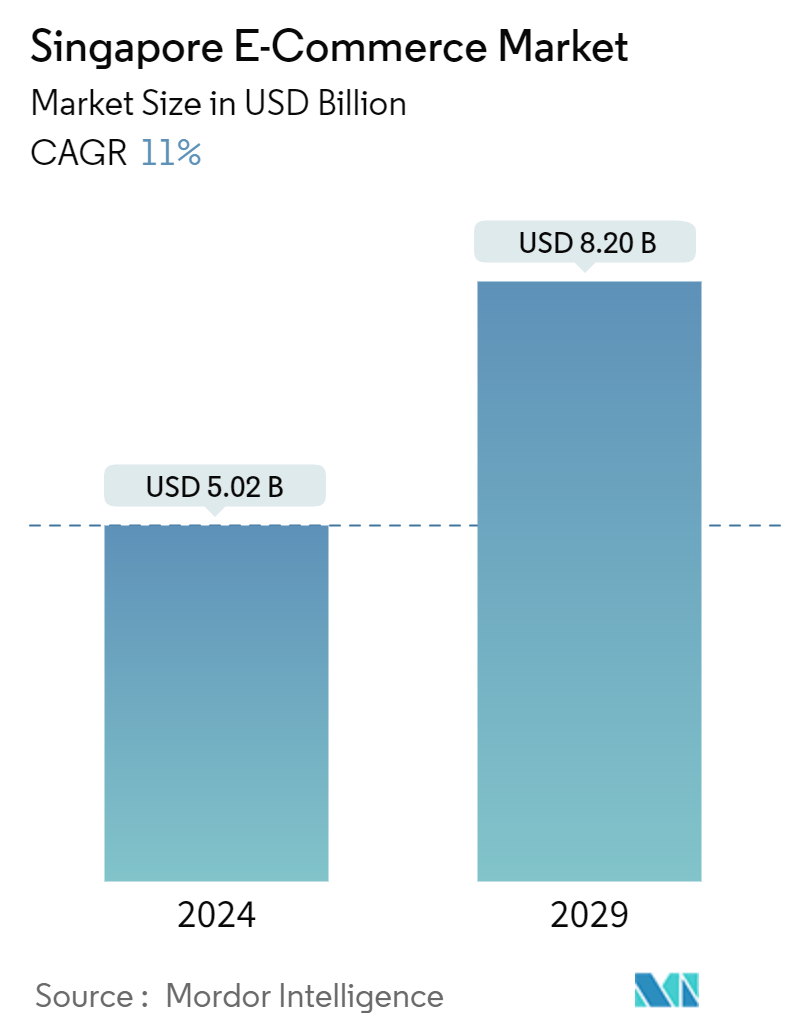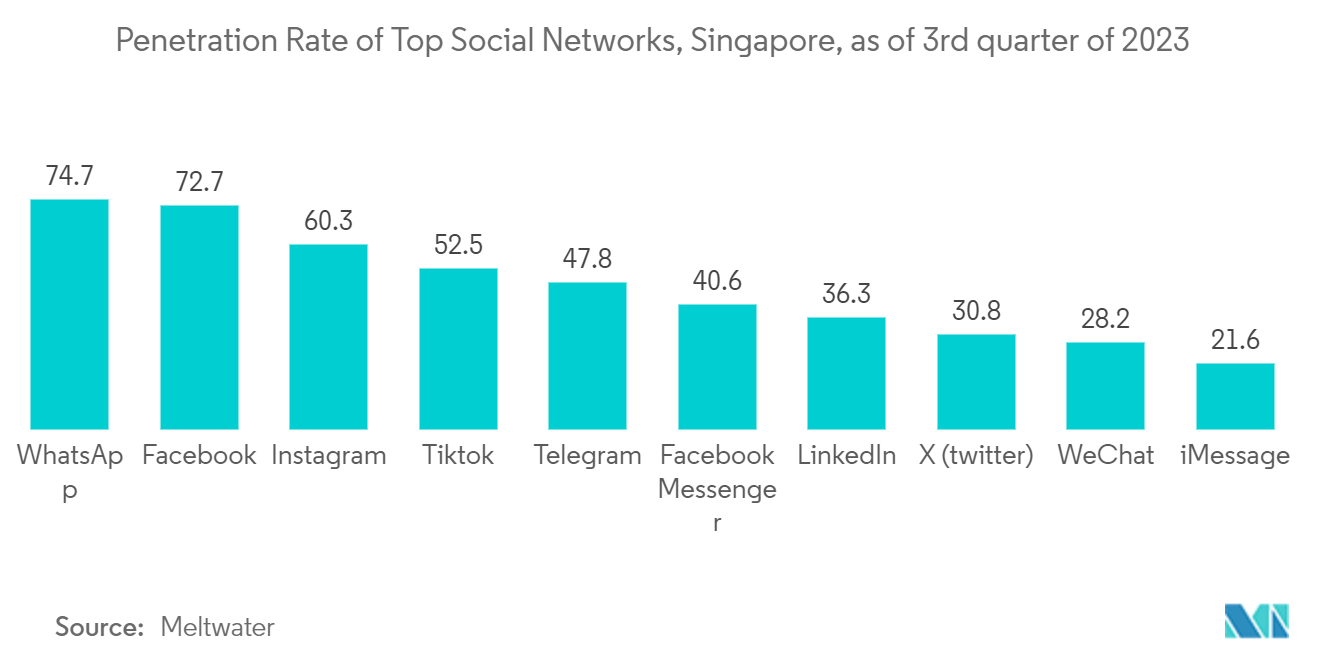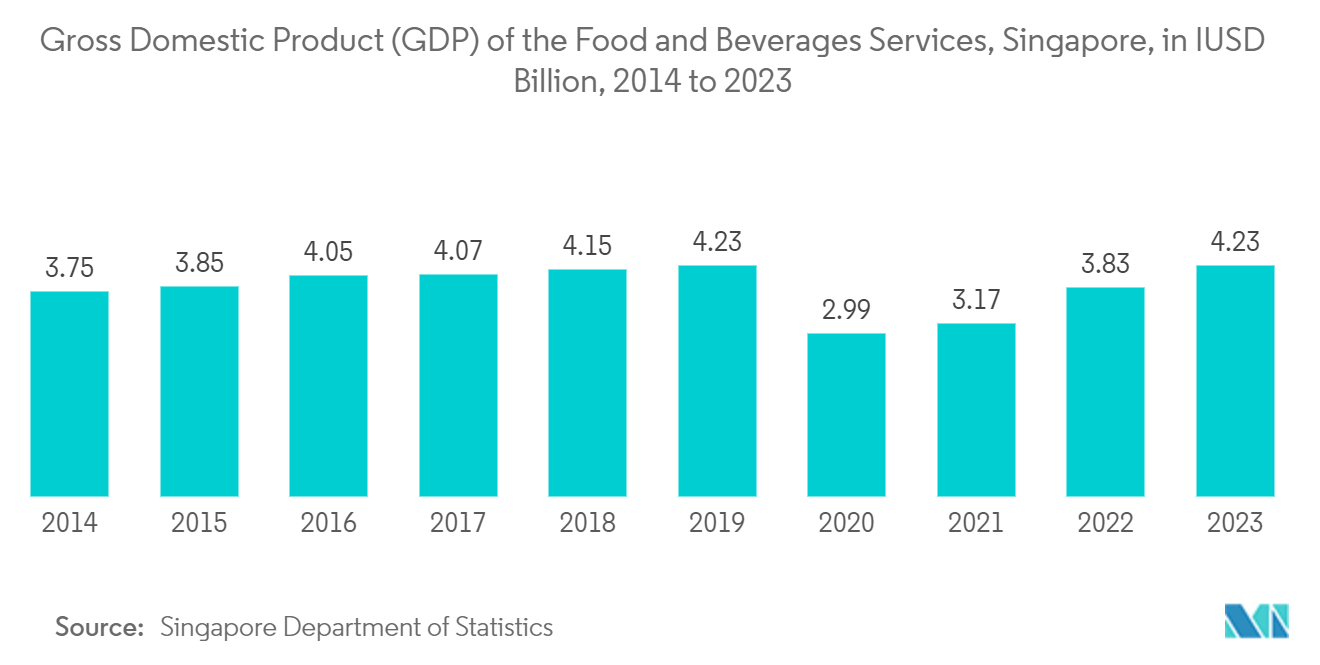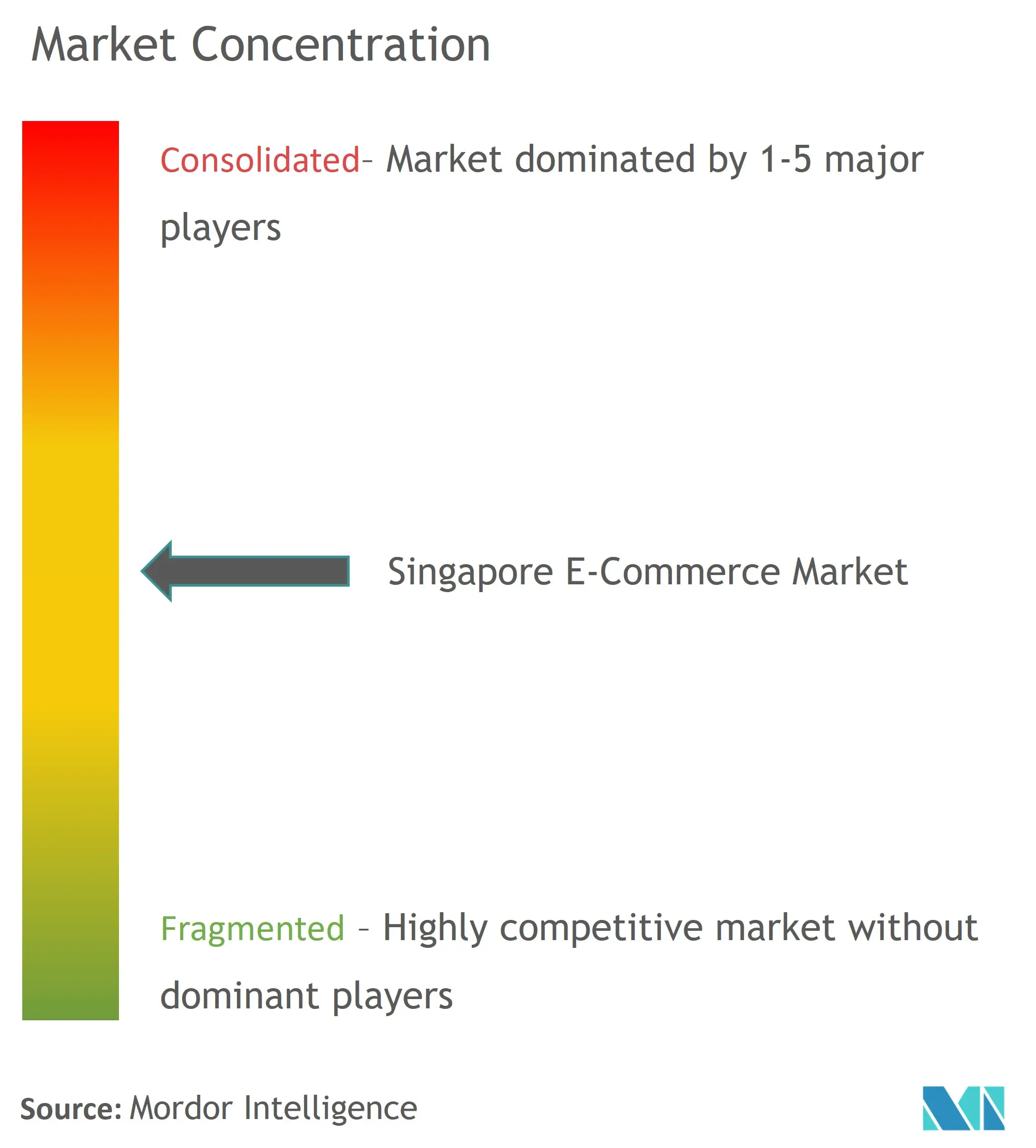Singapore E-Commerce Market Size

| Study Period | 2019 - 2029 |
| Base Year For Estimation | 2023 |
| Market Size (2024) | USD 5.02 Billion |
| Market Size (2029) | USD 8.20 Billion |
| CAGR (2024 - 2029) | 11.00 % |
| Market Concentration | Low |
Major Players
*Disclaimer: Major Players sorted in no particular order |
Need a report that reflects how COVID-19 has impacted this market and its growth?
Singapore E-Commerce Market Analysis
The Singapore E-Commerce Market size is estimated at USD 5.02 billion in 2024, and is expected to reach USD 8.20 billion by 2029, growing at a CAGR of 11% during the forecast period (2024-2029).
- The rise of technology has ushered in a new age in the realm of business, and Singapore has readily welcomed this transformation. The expansion of e-commerce in Singapore has been extraordinary, as an increasing number of enterprises are shifting toward online channels to connect with their clientele. E-commerce platforms in the area are playing a vital role in enabling businesses to flourish in the digital sphere by facilitating the management of online marketplaces.
- The surge in the region's e-commerce market can be attributed to the growing popularity of mobile payment methods. With options like digital wallets, code-scanning payments, and mobile payments, users can conveniently and securely make purchases on their mobile devices. The rising use of mobile wallets in Singapore is a clear indication of the widespread acceptance of mobile payments. Additionally, the increasing internet connectivity in the region is playing a significant role in driving the adoption of mobile payment technologies. As mobile payments continue to gain traction, the e-commerce market in the region is poised for growth.
- Buy now pay later (BNPL) is a payment method that is gaining traction in the Singaporean e-commerce industry. By incorporating BNPL into their payment options, e-commerce websites can cater to a wider range of consumers, particularly the younger demographic. This allows consumers to receive their purchases upfront and make payments in installments based on their circumstances, enhancing the overall convenience and satisfaction of the shopping experience. The adoption of BNPL is increasing among both online platforms and brick-and-mortar stores, indicating a positive trend toward the expansion of the e-commerce market in the region.
- According to the International Trade of Administration (ITA), Singapore's e-commerce industry is experiencing rapid growth thanks to its widespread, high-speed, and reliable ICT infrastructure, as well as its tech-savvy population and the government's commitment to embracing the digital economy and achieving its goal of becoming a Smart Nation. The Government of Singapore is actively encouraging companies to utilize IT to enhance and grow their businesses. The growing government efforts to drive the e-commerce industry in the region are anticipated to be a major factor in the market's expansion.
- Moreover, according to the ITA, the gross merchandise volume of the Singaporean e-commerce market reached USD 8.2 billion in 2022, with forecasts suggesting an increase to USD 11 billion by 2025. Over the recent years, computer and telecommunications equipment have held a substantial portion of online sales, while furniture and household equipment have also secured a significant share. Other major product categories in the market studied include fashion, food, cosmetics and personal care, and toys. The substantial investments made by the e-commerce platforms in the region are also playing a significant role in the market's growth.
- The e-commerce market in Singapore places a greater emphasis on the quality and pricing of goods than its surrounding nations. Temasek Holdings reported that the gross merchandise volume (GMV) of the Singaporean e-commerce market reached USD 8 billion in 2023, with projections to hit USD 10 billion by 2025. Singapore has solidified its position as Southeast Asia's most advanced e-commerce market.
- The rise of social e-commerce is gaining more importance. By integrating social media, social e-commerce platforms have effectively merged the social aspect with the shopping aspect to cater to the evolving social and shopping demands of customers. With ongoing technological advancements and shifts in consumer behavior, e-commerce is projected to expand rapidly through social media promotions and play a progressively vital role in Singapore's e-commerce industry. Moreover, e-commerce websites will persist in evolving and innovating to meet the changing needs of consumers and keep up with the rapid advancements in technology.
- Following the COVID-19 pandemic, the Singaporean e-commerce market experienced a profound transformation. Changes in consumer behavior were accelerated, digital engagement surged, and competition intensified. The future landscape of e-commerce in Singapore is anticipated to be shaped by omni-channel approaches, social commerce, and advancements in logistics and delivery services. Government involvement is expected to be pivotal in determining the trajectory of Singapore's e-commerce industry.
Singapore E-Commerce Market Trends
Internet Plays a Significant Role in Market Growth
- The internet has played a crucial role in shaping the landscape of e-commerce, converting traditional markets into global platforms. This evolution has empowered businesses to market their products and services worldwide, facilitating smoother transactions and documentation processes. Additionally, the internet has transformed the dynamics of communication, interaction, and transactions between businesses and consumers on a global scale. With rising internet usage, expanding mobile internet user base, and investments in driving the adoption of 5G technology, the e-commerce market in the region is anticipated to witness significant growth.
- Singapore has seen a rapid increase in internet and social media usage, resulting in a vibrant online community where users interact with diverse content and dedicate a substantial amount of time to video-based social media platforms. This trend is projected to persist, positioning Singapore as a frontrunner in digital engagement. The surge in Internet and social media adoption has also fueled a notable expansion in e-commerce for consumer goods. As Internet usage continues to grow, the popularity of online shopping and digital services is anticipated to increase, consequently boosting market growth.
- The region is experiencing a surge in internet usage, propelled by rising broadband speeds, the adoption of online payments, and the advancements in 5G technology. 5G's utilization of millimeter waves (mmWaves) allows for increased capacity, especially in densely populated regions, heightened scalability, improved user mobility (even in moving vehicles), and enhanced connectivity across the board. This enhanced mobile broadband ensures that the broader public can access high-quality internet services, even in previously challenging conditions.
- As per GO-Globe, the adoption and integration of 5G is set to revolutionize connectivity in Singapore, bringing in a new era of innovation, productivity, and economic growth. With continued investment in 5G infrastructure and establishing a conducive regulatory environment, Singapore is well-positioned to emerge as a global leader in the digital economy. It is predicted that 5G subscriptions will surpass 4G subscriptions by 2025 and is expected to represent 76% of total mobile subscriptions by the end of 2027, which is likely to positively impact the e-commerce market in the region.
- As per the data provided by GO-Globe, the current mobile penetration rate in Singapore stands at 169.6%, with an estimated 1.31 million mobile phone subscriptions as of February 2024. It is projected that 55% of total worldwide connections will be 5G in Singapore by 2025. Singtel, StarHub, and M1 are the key providers responsible for the operation of 5G networks across the nation. Singtel took the lead in this advancement, achieving over 95% standalone coverage by July 2022, surpassing the government's 2025 target by three years. These significant advancements and the increasing activities of vendors are expected to greatly boost the market's growth.
- Nokia revealed in February 2023 that it secured a ten-year extension to its current nationwide 5G network agreement with Antina, the joint venture established by mobile network operators M1 and StarHub in Singapore, after a rigorous tender process. This agreement entails Nokia setting up a 5G standalone (SA) network to provide indoor and outdoor coverage, along with enhancing the current network using Antina's 3.5 GHz spectrum assets. The collaboration is expected to enhance the 5G connectivity for both businesses and consumers, supporting Singapore's dynamic 5G ecosystem. Such vendor activities in driving the 5G adoption in the region are expected to drive the growth of the e-commerce market.

The Food and Beverage Industry is Driving Market Growth
- According to the Singapore Department of Statistics, the gross domestic product (GDP) of Singapore's food and beverage services was around SGD 5.26 billion (USD 4.02 billion), up slightly from the past years. The reduction is attributable to the foodservice industry's unfavorable impact of the COVID-19 pandemic.
- While customer preferences for dining in have stayed unchanged, the response to constant adjustments in safe management limits appears to have moved this year, according to data from the Customer Satisfaction Index of Singapore (CSISG). Surprisingly, the fall in dine-in numbers was met with a considerable increase in takeout, while delivery proportions remained steady.
- According to the Singapore Department of Statistics, food and beverage service sales increased by 4.7% year-over-year in March 2023, reversing a 0.7% dip in February 2023. Over the previous month, food and beverage service sales climbed 8.0%, seasonally adjusted in March 2022. In 2023, the food and beverage services industry in Singapore saw its gross domestic product (GDP) reach around SGD 5.67 billion (USD 4.23 billion), marking a 10.5% growth from the previous year's figure of SGD 5.14 billion (USD 3.83 billion). The industry has shown significant improvement following the COVID-19 pandemic, especially after Singapore removed all dining restrictions in 2022.
- According to Value Champion, GrabFood recorded the highest delivery fee ratio to the total order cost, at 21%, according to a review of leading meal delivery apps in Singapore. With a fee ratio of 9%, Foodpanda recorded the lowest average fee ratio. The fee ratio was obtained by dividing the average delivery fee total by the average total cost of the delivery order.
- In April 2023, Wakao Foods, a plant-based food brand, was set to debut in Singapore. The brand was expected to introduce seven of its signature products, ranging from Butter Jack and BBQ Jack to Hot & Spicy Sausages. These offerings, which include Continental and Jack Supreme Burger Patties, will be stocked at prominent retail outlets like Everyday Vegan Grocer and HoReCa. Additionally, consumers can find Wakao's products on leading e-commerce platforms, including Shopee, Lazada, Amazon Singapore, and Redmart.
- The region is also witnessing significant initiatives in maintaining safety standards for the e-commerce food products in the region's e-commerce platform. For instance, food retail through online channels like e-commerce websites, social media platforms, and food delivery services is becoming more common in Singapore. The Singapore Standard (SS) 687: 2022 (Guidelines for Food E-commerce) was introduced on January 13, 2023. This standard outlines recommended practices and essential procedures for the food e-commerce industry to enhance the quality and safety of food items sold online. It is recommended that online food vendors, e-commerce platforms, and food delivery firms adhere to this standard in the area.
- The increase in the number of coffee and snack outlets is one of the main drivers of the growth of the fast food and coffee business. Specialty coffees have emerged due to the diversity of tastes and preferences for various varieties of premium coffee, which is driving the market's growth. According to the US Department of Agriculture, Singapore consumed 100,000 60 kg bags of coffee in June before the previous year. In recent years, the increase in cafes, chain coffee shops, and specialty coffee houses has contributed to rising coffee consumption.

Singapore E-Commerce Industry Overview
In Singapore, competition in the e-commerce market has increased as the adoption of online sales channels by customers has grown. The market is moderate. An increase aids this growth in internet penetration. Furthermore, brands such as Lazada and Shopee are expanding their reach by providing customer-centric services that enhance customers' online shopping experience.
- July 2023 - Amazon Global Selling introduced its inaugural cross-border e-commerce brand launchpad in Singapore, aimed at assisting SMEs in tapping into growth prospects in cross-border e-commerce. The newly established "Singapore Cross-border Brand Launchpad" initiative, created in collaboration with Enterprise Singapore and the Singapore Business Federation, is set to aid more than 100 local Singapore MSMEs in launching and expanding their brands, as well as gaining access to export opportunities in the United States within the next 24 months.
Singapore E-Commerce Market Leaders
-
Lazada
-
Shopee
-
EZbuy
-
Amazon.com Inc
-
Sephora
*Disclaimer: Major Players sorted in no particular order

Singapore E-Commerce Market News
- August 2023 - Sea, an e-commerce giant, revealed its plans to increase investments in its online shopping platform, Shopee, across all markets. This decision was taken as TikTok's shopping venture from China expanded into new territories.
- June 2023 - As part of its effort to support over 120,000 small businesses in the area, the social media platform TikTok planned to launch a program to offer e-commerce training for stores in the Heartlands. For Heartland stores in Singapore, TikTok is expected to roll out a thorough, systematic digital training program that may help them establish a presence online in a secure, open, and approachable manner.
Singapore Ecommerce Market Report - Table of Contents
1. INTRODUCTION
1.1 Study Assumptions and Market Definitions
1.2 Scope of the Study
2. RESEARCH METHODOLOGY
3. EXECUTIVE SUMMARY
4. MARKET INSIGHTS
4.1 Market Overview
4.2 Industry Attractiveness-Porter's Five Forces Analysis
4.2.1 Bargaining Power of Suppliers
4.2.2 Bargaining Power of Buyers/Consumers
4.2.3 Threat of New Entrants
4.2.4 Threat of Substitute Products
4.2.5 Intensity of Competitive Rivalry
4.3 Key Market Trends and Share of E-commerce of Total Retail Sector
4.4 Impact of COVID-19 on the E-commerce Sales
5. MARKET DYNAMICS
5.1 Market Drivers
5.1.1 Increased Internet Penetration Across the Country
5.1.2 Increased Adoption of Smartphones
5.2 Market Challenges
5.2.1 Data Security
5.3 Analysis of Key Demographic Trends and Patterns Related to the E-commerce Industry in Singapore (Coverage to include Population, Internet Penetration, E-commerce Penetration, Age & Income, etc.)
5.4 Analysis of the Key Modes of Transaction in the E-commerce Industry in Singapore (coverage to include prevalent modes of payment such as cash, card, bank transfer, wallets, etc.)
5.5 Analysis of Cross-border E-commerce Industry in Singapore (Current Market Value of Cross-border and Key Trends)
5.6 Current Positioning of Singapore in the E-commerce Industry in Asia
6. Market Segmentation
6.1 By B2C E-commerce
6.1.1 Market Size (GMV) for the Period of 2022-2029
6.1.2 Market Segmentation - by Application
6.1.2.1 Beauty and Personal Care
6.1.2.2 Consumer Electronics
6.1.2.3 Fashion and Apparel
6.1.2.4 Food and Beverage
6.1.2.5 Furniture and Home
6.1.2.6 Other Applications (Toys, DIY, Media, etc.)
6.2 By B2B E-commerce
6.2.1 Market Size (GMV) for the Period of 2022-2029
7. Competitive Landscape
7.1 Company Profiles
7.1.1 Lazada
7.1.2 Shopee
7.1.3 EZbuy
7.1.4 Amazon.com Inc.
7.1.5 Sephora
7.1.6 E Bay
7.1.7 Alibaba Group Holding Ltd
7.1.8 Flipkart
7.1.9 Carousell
7.1.10 RedMart
- *List Not Exhaustive
8. Investment Analysis
9. Future Outlook of the Market
Singapore E-Commerce Industry Segmentation
Electronic commerce (e-commerce) is a business model that allows consumers and businesses to buy and sell goods and services over the internet.
The Singaporean e-commerce market is segmented by B2C e-commerce and B2B e-commerce. By B2C e-commerce, the market is segmented into beauty and personal care, consumer electronics, fashion and apparel, food and beverage, furniture and home. For each segment, the market sizes and forecasts are provided in terms of value (USD).
| By B2C E-commerce | ||||||||
| Market Size (GMV) for the Period of 2022-2029 | ||||||||
|
| By B2B E-commerce | |
| Market Size (GMV) for the Period of 2022-2029 |
Singapore Ecommerce Market Research FAQs
How big is the Singapore E-Commerce Market?
The Singapore E-Commerce Market size is expected to reach USD 5.02 billion in 2024 and grow at a CAGR of 11% to reach USD 8.20 billion by 2029.
What is the current Singapore E-Commerce Market size?
In 2024, the Singapore E-Commerce Market size is expected to reach USD 5.02 billion.
Who are the key players in Singapore E-Commerce Market?
Lazada, Shopee, EZbuy, Amazon.com Inc and Sephora are the major companies operating in the Singapore E-Commerce Market.
What years does this Singapore E-Commerce Market cover, and what was the market size in 2023?
In 2023, the Singapore E-Commerce Market size was estimated at USD 4.47 billion. The report covers the Singapore E-Commerce Market historical market size for years: 2019, 2020, 2021, 2022 and 2023. The report also forecasts the Singapore E-Commerce Market size for years: 2024, 2025, 2026, 2027, 2028 and 2029.
Singapore E-Commerce Industry Report
Statistics for the 2023 Singapore E-Commerce market share, size and revenue growth rate, created by Mordor Intelligence™ Industry Reports. Singapore E-Commerce analysis includes a market forecast outlook to 2029 and historical overview. Get a sample of this industry analysis as a free report PDF download.

